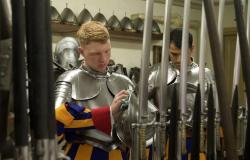April 23, 2024
Today at
1:00 pm
A clever device for tokens the size of a coin. OnTracx, a spin-off from Ghent University, hopes to eliminate injuries caused by overload. ‘Many people have no idea how much strain they put on their body when walking.’
Senne Bonnaerens (32) is stamping her feet in a meeting room. With a smartphone in his hand and a black device around his lower leg, he pretends to be jogging. ‘Look, if I stomp heavily while walking, I get a message that I am putting intensive strain on my body. If I go for a lighter pass, the meter drops back into a safe green zone. This way you can quickly see whether you are doing the right thing.’
Full screen display
More than half of runners suffer an overuse injury once a year. Rest a bit, do muscle-strengthening exercises and advise ‘build up carefully’; physiotherapists often put forward this solution. ‘But actually the physiotherapists, sports coaches and their patients are sailing blind. Many people have no idea how much they are putting a strain on their body and how they can build up properly so that their body can recover,” says Bonnaerens. Together with Kristof De Mey (42) and Rud Derie (31), he founded OnTracx, a young start-up from Ghent.
OnTracx has succeeded in creating a wearable – it looks like a 2 euro coin – that can accurately measure the mechanical stress on the body (see inset). Behind the technology are algorithms that Bonnaerens and Derie helped devise during their doctoral research running biomechanics at Ghent University. This is a scientific branch that applies physics to walking humans, by examining, among other things, how walking styles influence the load. And what role factors such as running footwear and the surface play in this.
How does OnTracx work?
OnTracx developed a wearable that runners can wear just above the ankle. During training, the sensor measures the load on the joints, tendons and muscles, expressed in G-force. That value, officially the free-fall acceleration, indicates the total force acting on a moving object. A G-force of 3 feels like three times your body weight.
How much G-force leads to overload depends on the runner. In addition to the G-force, this will be shown a color, where red, for example, stands for a risk zone and green for no heavy load. ‘For some, 5 G is too much, while others can handle more than 10 G. Recently we went running with two people and we noticed that one runner had burdened himself no less than 35 percent more than the other,” says CEO Senne Bonnaerens. ‘You can compare it a bit with heart rate zones. Not everyone suffers equally at a certain heart rate.’
During a training you can connect the wearable to an application that keeps track of all data per running session. Every week OnTracx calculates a total accumulated load, adding up all training sessions. ‘This way, runners can monitor how they gradually build up the load. This allows the body to adapt better, with the aim of avoiding future running injuries,” says Bonnaerens.
Measuring walking loads is not new, but it is only possible in specialized labs equipped with force plates and sophisticated cameras. Classic running analyses, such as Runners’ lab or sports specialty stores offer, do not have this technology. OnTracx is changing that and is selling the sensor and the accompanying app from today for 199 euros. ‘The cost of a decent running shoe, we reasoned.’
There are 120 million active runners in Europe and the United States. 18 to 20 percent of them are often injured and are interested in technology. We want to exploit that potential.
Senne Bonnaerens
Co-founder OnTracx
To 10,000 pieces per year
Does every runner need that pricey gadget? ‘No. Anyone who has never had any problems should not buy OnTracx. If you are just starting with Start To Run, you don’t need us yet,” says CEO Bonnaerens. He targets athletes with a history of injuries who do not want to give up running. ‘There are 120 million active runners in Europe and the United States. 18 to 20 percent of them are often injured and are interested in technology. We want to exploit that potential.’
For the development of the sensor, OnTracx raised 260,000 euros from the accelerator Imec.istart, Bluehealth Innovation Fund and several smaller investors, including a business angel from the United States. The start-up hopes to sell 500 to 800 copies in the Benelux this year. Next year the trio aims for 2,000 units, after which they want to quickly scale up to 10,000 units per year. ‘We go to market relatively quickly, because we count on feedback from our users.’
The system is not yet completely ready. “The next step is integration with sports watches and running applications such as Strava,” say the founders. ‘Just as you can now monitor your speed, distance and heart rate in real time, we also want the physical strain during exercise to appear on your watch. This way you know immediately whether you are training correctly.’





